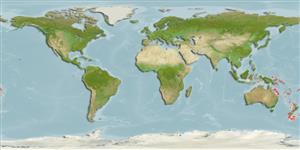Classification / Names
Common names | Synonyms | Catalog of Fishes (gen., sp.) | ITIS | CoL | WoRMS | Cloffa
Elasmobranchii (sharks and rays) >
Rajiformes (Skates and rays) >
Arhynchobatidae (Skates)
Etymology: Pavoraja: Latin, pavo = peacock + Latin, raja, -ae = a sting ray (Raja sp.) (Ref. 45335); pseudonitida: Name from Greek 'pseudos' for false, with Latin 'nitidus' for elegant, refers to the superficial resemblance to its congener Pavoraja nitida.. More on author: Last.
Environment / Climate / Range
Ecology
Marine; bathydemersal; depth range 212 - 512 m (Ref. 76878). Tropical, preferred ?
Western Pacific: Australia.
Length at first maturity / Size / Weight / Age
Maturity: Lm ?, range 32 - ? cm
Max length : 37.2 cm TL male/unsexed; (Ref. 76878)
Life cycle and mating behavior
Maturity | Reproduction | Spawning | Eggs | Fecundity | Larvae
Last, P.R., S. Mallick and G.K. Yearsley, 2008. A review of the Australian skate genus Pavoraja Whitley (Rajiformes: Arhynchobatidae). Zootaxa 1812:1-45. (Ref. 76878)
IUCN Red List Status (Ref. 115185)
CITES (Ref. 94142)
Not Evaluated
Threat to humans
Harmless
Human uses
More information
Age/Size
Growth
Length-weight
Length-length
Length-frequencies
Morphometrics
Morphology
Larvae
Larval dynamics
Recruitment
Abundance
ReferencesAquacultureAquaculture profileStrainsGeneticsAllele frequenciesHeritabilityDiseasesProcessingMass conversion
Tools
Special reports
Download XML
Internet sources
Estimates of some properties based on models
Phylogenetic diversity index (Ref.
82805): PD
50 = 0.5156 [Uniqueness, from 0.5 = low to 2.0 = high].
Bayesian length-weight: a=0.00513 (0.00253 - 0.01042), b=3.12 (2.95 - 3.29), in cm Total Length, based on LWR estimates for this (Sub)family-body shape (Ref.
93245).
Trophic Level (Ref.
69278): 3.7 ±0.7 se; Based on size and trophs of closest relatives
Resilience (Ref.
69278): Medium, minimum population doubling time 1.4 - 4.4 years (Preliminary K or Fecundity.).
Vulnerability (Ref.
59153): Moderate vulnerability (38 of 100) .
